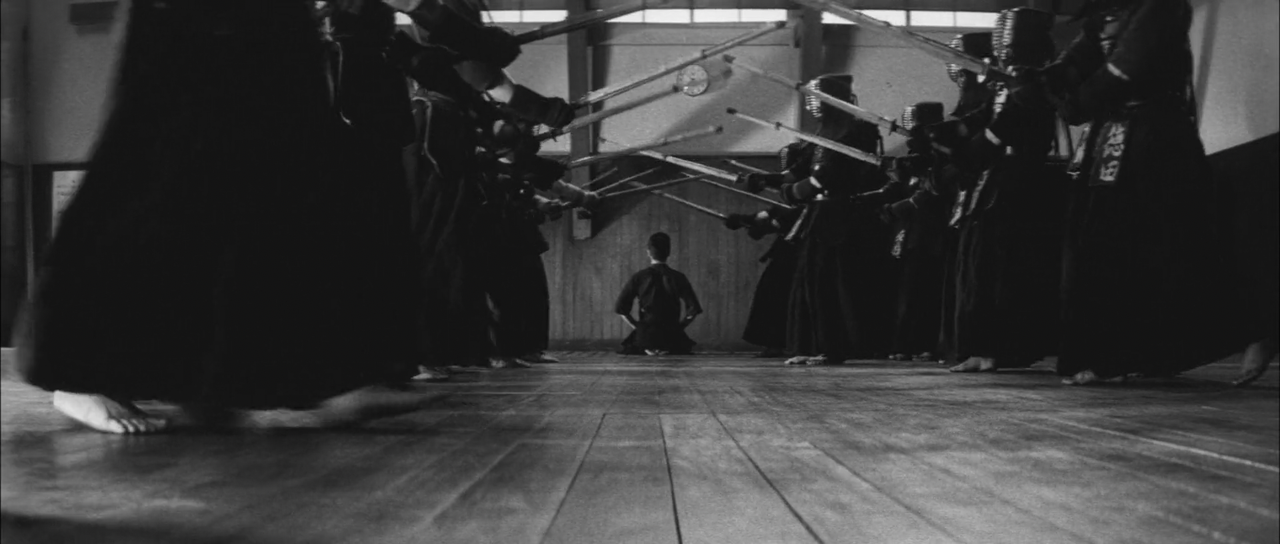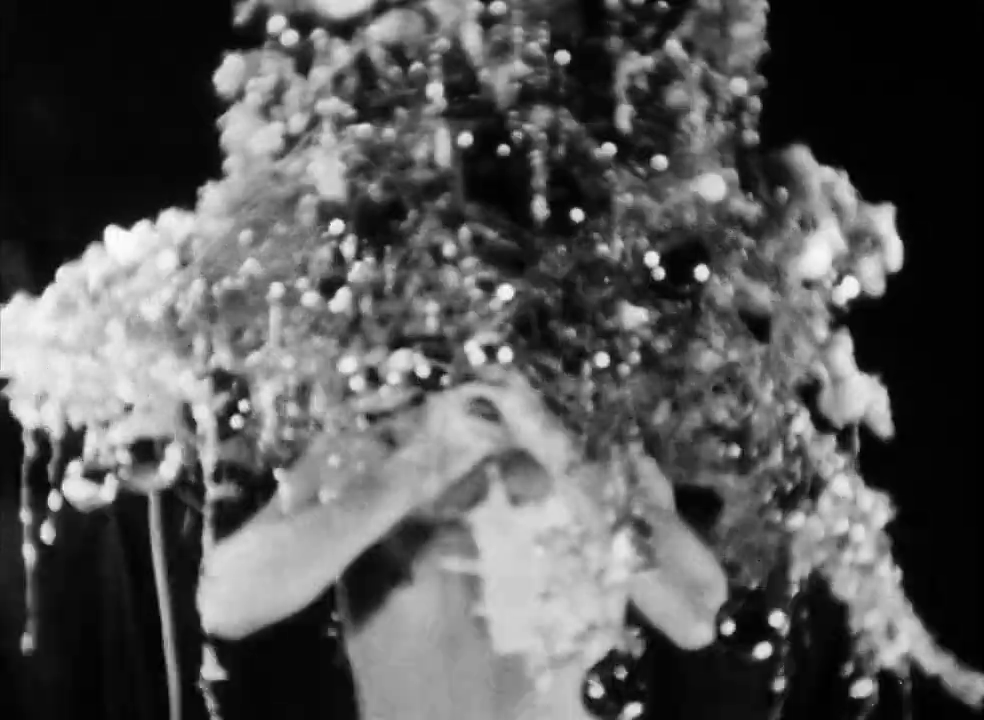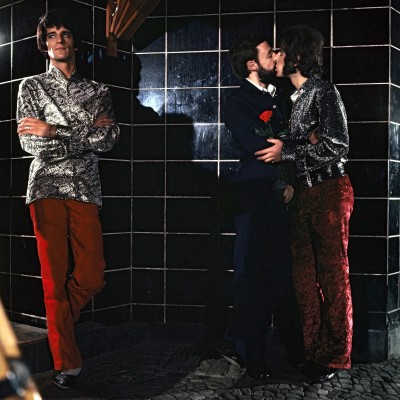– So what is your goal in life then? – Satisfaction of the present. The sword, and nothing else.剣 (小説) [Ken / The Sword] (Kenji Misumi, 1964)
Dec
29
Tick Tock Day

One of the kendōka kneeled on the floor in gruelling punishment faces a clock on the wall, while the other students continue their training. DP: Chikashi Makiura.
A clock face on Tick Tock Day (USA)
After World War II, the Japanese martial arts of #kendo was banished by the occupying forces in an attempt to “remove and exclude militaristic and ultra-nationalistic persons from life”. With that in mind, it makes complete sense that nationalist author and former kendo practitioner Yukio Mishima wrote a short story – Sword, originally published in literary magazine Shincho in 1963 – about the art.
Both the story and Kenji Misumi's 1964 film adaptation follow arrogant kendo student Jiro, played by sublime kabuki actor Raizō Ichikawa who also appears in an earlier Mishima adaptation, 炎上 [Enjō / The Temple of the Golden Pavilion / Conflagration] (1958).
LGBT
“Inflammable desires dampened by day under the cold water of consciousness are ignited that night by the libertarian matches of sleep, and burst forth in showers of shimmering incandescence.”Fireworks (Kenneth Anger, 1947)
Dec
8
National Christmas Tree Day

The Dreamer (Kenneth Anger) holding a tinsel-decked Christmas tree in front of his naked upper body. The scene appears to foreshadow Yvonne Marquis getting into her silver dress in Anger's Puce Moment (1949).
A Christmas tree for National Christmas Tree Day (USA)
In August 1942, a Mexican-American man with a broken finger was found semiconscious near Sleepy Lagoon, Ca.. By association, a group of young Latinos was put on trial. This spark, mere months after Roosevelt sent thousands of Japanese Americans to concentration camps and fuelled by Cold War paranoia, eventually set off the Zoot Suit Riots.
Zoot Suiters or Pachucos and other “outsiders” like African, Italian and Filipino Americans, were viciously attacked by Anglo-American #sailors. Those suits, all that fabric, this colourful extravagance, they cried out, were hampering the war effort.
– The Dreamer
The Dreamer, Anger, dreams of a similar violent attack. The sadism is harrowing, filmed with such exquisite eye that it's impossible to look away. Blood finds its way out, pulsating and spurting. Ambiguous glances. A hand, no finger. A young man awakes, is born. The dreamer is still asleep.
“We come to life, we die… It's a perpetual renewal. How boring.”剣 (小説) [Ken / The Sword] (Kenji Misumi, 1964)
Dec
6
rice

Young people eating. An older woman in kimono scoops rice from an electric rice cooker. When read from right to left, this scene – as are numerous others in Chikashi Makiura's photographed 剣 (小説) – are split into tradition and modernity. DP: Chikashi Makiura.
– Mibu
“Men! The beasts! God would show wisdom if he took the hands from all of them!” The Unknown (Tod Browning, 1927)
Dec
3
Let's Hug Day

Target girl Nanon (Joan Crawford) hugs her circus partner, Alonzo (Lon Chaney) the knife thrower. Her tight embrace may reveal his secret. DP: Merritt B. Gerstad.
Someone's hugged on Lets Hug Day (USA)
Nanon Zanzi (Joan Crawford) is mortally afraid of men. Of their grabbing, grasping, groping hands. This is why she only trusts her knife throwing partner Alonzo the Armless (Lon Chaney). What she doesn't know is that Alonzo and his 4'10”/1,47 m accomplice Cojo (that great staple of precode horror Tufei Filhela aka John George), use the #circus to hide from the long arm of the law, who is looking for a murderer with a deformed thumb. Who would suspect an armless man?
– Nanon Zanzi
As mighty as Alonzo may be, the incomparable Lon Chaney owes much to armless violinist and knife thrower “Judge” Paul Desmuke. Story goes that Desmuke taught Chaney his knife act in two months. More probable is that some of the more impressive close-up scenes show the Judge's, not Chaney's, feet.
Like Alonzo, The Unknown has lost some flesh. Until 1968, only mangled bootlegs were available; a complete print was considered non-existent. Five years later, news broke about film reels of unknown origin labelled inconnu – [the] unknown, somewhere in the bowels of the Cinémathèque Française.
Some 14 minutes, outlining the Armless' background, are still missing. Do check your attic.
The Leather Boys (Sidney J. Furie, 1964)
Oct
17
National Motorcycle Ride Day

Pete (Dudley Sutton) in his black leather tiger jacket waiting for Reggie (Colin Campbell). He leans against a window pane while Reggie drives up. It's raining and Reg is merely a blur. DP: Gerald Gibbs.
Glen or Glenda (1953)
In an intimate moment, Barbara (Dolores Fuller) hands Glen (Ed Wood) her angora sweater. DP: William C. Thompson.

August 25: someone wears another person's clothes on #NationalSecondhandWardrobeDay
Glen or Glenda [aka Male or Female aka Glen or Glenda, Which Is It? aka I Led 2 Lives] (Edward D. Wood Jr., 1953)
“Give this man satin undies, a dress, a sweater and a skirt, or even the lounging outfit he has on, and he's the happiest individual in the world. He can work better, think better, he can play better, and he can be more of a credit to his community and his government because he is happy.” —Dr. Alton, narrator
In 1953, Christine Jorgensen – who had widely reported sex reassignment surgery the year before – was approached by schlocky Z movie producer George G. Weiss to be in an exploitation movie about her voyage. She kindly thanked for the offer. Who did bite was the producer's pick to be the director, novice movie maker and transvestite Edward D. Wood Jr.. Wood reworked the script.
The resulting effort – Glen or Glenda – is not only an utterly unique autobiographic docudrama; it's a lovingly composed pamphlet in support of (heterosexual) transvestism – both fetish and lifestyle, not to be confused with drag – and transsexualism to boot. Rarely sex-related outsider lifestyles were discussed this frankly; Kinsey's Sexual Behavior in the Human Male came out only five years prior and the volume about the human female in the year of this movie.
It's also pretty unique when it comes to the art of filmmaking. However contagiously enthusiastic, Wood didn't have the skill, weight, or budget to make movies. He'd pad story lines and plot holes with stock footage and long-winded dream sequences of the sexploitation kind. Like John Waters after him, Ed would cast friends and family – Dolores Fuller was his real-world girlfriend – and cinematic idols such as Bela Lugosi, who by 1953 was addicted to alcohol and prescription drugs.
Wood's life was wild and colourful. He once said that while serving in the US Marine Corps, he feared injury more than death, worried that the combat medic would discover the pink bra and panties under his uniform. It makes me wonder if the full colour promotional material for Psycho (1960) was #Hitchcock sending out a little wink to Ed.
Marion Crane (Janet Leigh) wearing pink undergarments on a lobby card for Psycho (1960). The movie itself is in black and white and the reveal of Marion wearing pink underwear came as a shock in early-60s prissy America. DP: John L. Russell.
#Bales2023FilmChallenge #EdwardDWoodJr #BelaLugosi #LyleTalbot #DoloresFuller #ConradBrooks #WilliamCThompson #fashion #angora #crossdressing #sweaters #LGBT #fetishism #drag #docudrama #biography #USA #1950s
El lugar sin límites [The Place Without Limits] (Arturo Ripstein, 1978)
Aug
13
Gay Uncles Day

Pancho (Gonzalo Vega) watches La Manuela (Roberto Cobo) dance flamenco for him. DP: Miguel Garzón.
Cabaretera, a sub-genre from the Epoca de Oro (the golden epoch of Mexican filmmaking, 1930s—1950s), combines film noir with melodrama and musical numbers. Often set in cabarets (brothels), these films talk about the plight of the prostitute who – not without their pride and dignity – are forced to being the breadwinner in a poverty-stricken community.
El lugar sin límites harks back to those days. We follow the plight of La Manuela, a transvestite* who together with daughter La Japonesita works as a fichera (a dancehall performer) in the brothel run by Madame La Japonesa, La Japonesita's mother.
The return of Pancho, a hyper-macho trucker, disrupts the family regime. The trucker's attraction to the #flamenco dancing fichera is at odds with his machismo. Him being outed as a maricón (a Mexican slur for homosexual) would be the end of his world.
El lugar remains a groundbreaking film, not only in how it handles taboos like #gender roles and trans- and homosexuality, but also because it highlights how (self) destructive #machismo is in Mexican society.
Sergio de la Mora's excellently researched EL LUGAR SIN LÍMITES: Ripstein in Review delves much deeper than this little writeup here. Do read it (spoilers ahead).
*Roberto Cobo's La Manuela is transsexual. The term “transvestite” is what's used in the film and typical for its time.
“Now I may die content, for I have seen great love.”Michael [Mikaël / Chained: The Story of the Third Sex / Heart's Desire] (Carl Theodor Dreyer, 1924)
Aug
3
National Michael Day

Art critic Switt (Robert Garrison) with muse Michael (Walter Slezak). DPs: Karl Freund & Rudolph Maté.
Considered one of the earliest positive cinematic depictions of (male) homosexuality, Carl Theodor Dreyer's Michael tells the story of lonely artist Zoret (director Benjamin Christensen), his bright young muse and model Michael (Walter Slezak), and the more mature art critic Switt (Robert Garrison). Though it's mostly suggested – there's a female temptress (Nora Gregor) assuming a heterosexual perspective – its motif of the spoken and unspoken relationship between the men is definitely one of love, much in the same way Charles Vidor's Gilda (1946) is.
– opening title card
Michael is the second book adaption of Herman Bang's Mikaël (1902) after Vingarne [The Wings] (Mauritz Stiller, 1916).
“You say to the boy 'Open your eyes'. When he opens his eyes and sees the light, you make him cry out, saying 'Oh, Blue, come forth! Oh, Blue, arise! Oh, Blue, ascend! Oh, Blue, come in!'.”Blue (Derek Jarman, 1993)
Jul
13
Oxymoron Day

Not a screenshot from the film, but a pure representation of International Klein Blue.
Synchronous to the screening of a film that wasn't, Derek Jarman's Blue was broadcast on radio and television. Those who tuned into the radio could request a special card printed in that most spectral of colours, International Klein Blue, a blue that according to its creator Yves Klein, has “a quality close to pure space” and “immaterial values beyond what can be seen or touched”.
– Nigel Terry
Submerged in #blue, seeing through what was left of Jarman's eyes, we live through the artist's life, and love, and loss. When you leave the theatre, put down that card, you're temporarily blinded by the physiological afterimage of a devastating disease. What remains is the voice of a filmmaker who lost his sight.
“Werdet stolz auf eure Homosexualität! Raus aus den Toiletten, rein in die Strassen! Freiheit für die Schwulen!”Nicht der Homosexuelle ist pervers, sondern die Situation, in der er lebt [It Is Not the Homosexual Who Is Perverse, But the Society in Which He Lives] (Rosa von Praunheim, 1971)
Jul
6
National Daniel Day

A gay couple kissing on the street in front of a black-tiled Berlin bar. A third gay man nearby looks away. DP: Robert van Ackeren.
Daniel (Bernd Feuerhelm) is a young man in #WestBerlin exploring his homosexuality. Initially he opts for a spießbürgerlich, petit-bourgeois, almost heterosexual affair. He then probes further, swings by Berlin's public toilets and pools. Only when he encounters a leftwing gay commune he finds that pride, not conformity, is his way of living his life.
Von Praunheim's Nicht der Homosexuelle ist pervers is a plea for rebellion and visibility. For revolt and love. A wakeup call for gays and straights alike. Such a stir this film pamphlet made it became the blueprint for West-Germany's gay liberation movement.
